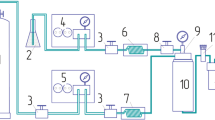Abstract
In this work, the Flory–Huggins parameters corresponding to the amorphous phase of a polyethylene (PE) and two ethylene–vinyl acetate (EVA) copolymers (with 18 and 33 % vinyl acetate content, respectively) samples, with different solvents have been determined below the melting temperature of the polymers, in order to quantify the bulk interactions of these polymer/solvent systems. The employed solvents were a dispersion solvent (cyclohexane), a polar solvent (vinyl acetate) and an association solvent (methanol). Initially, the inverse gas chromatography measurements allowed obtaining the retention volumes, activity coefficients and overall Flory–Huggins parameters of every polymer/solvent system. According to these parameters, in all cases, the more compatible solvent was cyclohexane, so it was selected as the probe to calculate the percentages of crystallinity at room temperature, whose results were in agreement the literature data (35 % for PE, 29 % for EVA18, and 12 % for EVA33). The percentage of crystallinity allowed determining the amorphous Flory–Huggins parameters which are the ones which take into account just the bulk interactions in a polymer/solvent mixture. The Flory–Huggins parameter results show that, to accurately study the vapor–liquid equilibrium between a polymer and a solvent (bulk interactions), when the range of studied temperatures is below the melting point of the polymer, it is crucial to calculate the amorphous contribution (χ amorphous) on the overall Flory–Huggins parameter. In the case of this study, the lower the vinyl acetate content (higher crystallinity), the higher the difference between the overall and amorphous Flory–Huggins parameters is. Analyzing the interactions between the three polymeric materials and the solvents it can be noticed that, for the most compatible solvent (cyclohexane), χ amorphous represents the less contribution, or the highest correction, to the overall Flory–Huggins parameter (around 50 % for PE and EVA18, and 79 % for EVA33, the less crystalline polymer).








Similar content being viewed by others
References
Chanda M, Roy SK (2008) Industrial polymers, specialty polymers, and their applications, vol 74. CRC Press, Boca Raton
Harper CA, Petrie EM (2003) Plastic materials and processes: a concise encyclopedia. Wiley, New York
Kawahara T, Hikasa T (2005) U.S. Patent No. 6,838,517. U.S. Patent and Trademark Office, Washington DC
Paricaud P, Galindo A, Jackson G (2004) Modeling the cloud curves and the solubility of gases in amorphous and semicrystalline polyethylene with the SAFT-VR approach and Flory theory of crystallization. Ind Eng Chem Res 43(21):6871–6889
Mathot VBF, Pijpers FJ (1983) Heat capacity, enthalpy and crystallinity for a linear polyethylene obtained by DSC. J Therm Anal Calorim 28(1):349–358
Shi XM, Zhang J, Jin J, Chen SJ (2008) Non-isothermal crystallization and melting of ethylene-vinyl acetate copolymers with different vinyl acetate contents. Express Polym Lett 2(9):623–629
Brandrup J, Immergut EH, Abe A, Bloch DR (eds) (1999) Polymer handbook, vol 89. Wiley, New York
Yazici O, Cakar F, Cankurtaran O, Karaman F (2009) Determination of crystallinity ratio and some physicochemical properties of poly(4-methyl-1-pentene). J Appl Polym Sci 113:901–906
Conder JR, Young CL (1979) Physicochemical measurement by gas chromatography. Wiley, New York
Al-Ghamdi A, Melibari M, Al-Saigh ZY (2005) Characterization of environmentally friendly polymers by inverse gas chromatography: I amylopectin. J Polym Environ 13(4):319–327
Rackett HG (1970) Equation of state for saturated liquids. J Chem Eng Data 15(4):514–517
Tsonopoulos C (1975) An empirical correlation of second virial coefficients. AIChE J 20(2):263–272
NIST Chemistry WebBook. http://webbook.nist.gov/chemistry/. Accessed July 2015
Romdhane IH, Plana A, Hwang S, Danner RP (1992) Thermodynamic interactions of solvents with styrene–butadiene–styrene triblock copolymers. J Appl Polym Sci 45(11):2049–2056
REPSOL-YPF catalogue. http://www.repsol.com/sa/herramientas/CatalogoQuimica/CatalogoQuimica.aspx. Accessed July 2015
Gaur U, Wunderlich B (1980) The glass transition temperature of polyethylene. Macromolecules 13(2):445–446
Sung YT, Kum CK, Lee HS, Kim JS, Yoon HG, Kim WN (2005) Effects of crystallinity and crosslinking on the thermal and rheological properties of ethylene vinyl acetate copolymer. Polymer 46(25):11844–11848
Chen CT, Al-Saigh ZY (1989) Characterization of semicrystalline polymers by inverse gas chromatography. 1. Poly (vinylidene fluoride). Macromolecules 22(7):2974–2981
Bieliński DM, Tranchida D, Lipiński P, Jagielski J, Turos A (2007) Ion bombardment of polyethylene—influence of polymer structure. Vacuum 81(10):1256–1260
Anderson K (2012) Crystallinity and its impact on ethylene vinyl acetate copolymers. VitalDose Blog. http://www.vitaldose.com/blog/crystallinity-and-its-impact-on-ethylene-vinyl-acetate-copolymers/. Accessed July 2015
Camacho J, Díez E, Ovejero G, Gómez L (2016) Inverse gas chromatography study of polyvinylacetate–solvent and polyethylene–solvent systems. Polym Eng Sci 56:36–43
Camacho J, Díez E, Ovejero G, Díaz I (2013) Thermodynamic interactions of EVA copolymer solvent systems by inverse gas chromatography measurements. J Appl Polym Sci 128:481–486
Author information
Authors and Affiliations
Corresponding author
Rights and permissions
About this article
Cite this article
Camacho, J., Díez, E. & Ovejero, G. Bulk polymer/solvent interactions for polyethylene and EVA copolymers, below their melting temperatures. Polym. Bull. 74, 11–25 (2017). https://doi.org/10.1007/s00289-016-1694-3
Received:
Revised:
Accepted:
Published:
Issue Date:
DOI: https://doi.org/10.1007/s00289-016-1694-3




